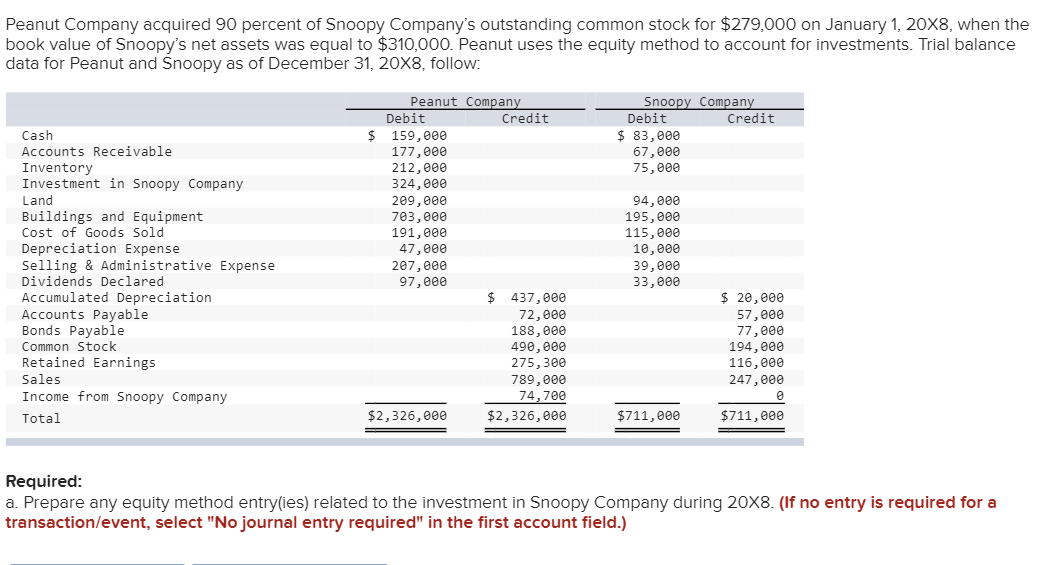Peanut Company acquired 90 percent of Snoopy Company's outstanding common stock for $279,000 on January 1, 20X8, whe book value of Snoopy's net assets was equal to $310,000. Peanut uses the equity method to account for investments. Trial balar data for Peanut and Snoopy as of December 31, 20X8, follow: Cash Accounts Receivable Inventory Investment in Snoopy Company Land Buildings and Equipment Cost of Goods Sold Depreciation Expense Selling & Administrative Expense Dividends Declared Accumulated Depreciation Accounts Payable Bonds Payable Common Stock Retained Earnings Sales Income from Snoopy Company Total Peanut Company Debit $ 159,000 177,000 212,000 324,000 324,888 209,000 703,000 191,000 47,000 207,000 97,000 $2,326,000 Credit $ 437,000 72,000 188,000 490,000 275,300 789,000 74,700 $2,326,000 Snoopy Company Debit $ 83,000 67,000 75,000 94,000 195,000 115,000 10,000 39,000 33,000 $711,000 Credit $ 20,000 57,000 77,000 194,000 116,000 247,000 0 $711,000 Required: a. Prepare any equity method entry(ies) related to the investment in Snoopy Company during 20X8. (If no entry is required for a transaction/event, select "No journal entry required" in the first account field.)
Peanut Company acquired 90 percent of Snoopy Company's outstanding common stock for $279,000 on January 1, 20X8, whe book value of Snoopy's net assets was equal to $310,000. Peanut uses the equity method to account for investments. Trial balar data for Peanut and Snoopy as of December 31, 20X8, follow: Cash Accounts Receivable Inventory Investment in Snoopy Company Land Buildings and Equipment Cost of Goods Sold Depreciation Expense Selling & Administrative Expense Dividends Declared Accumulated Depreciation Accounts Payable Bonds Payable Common Stock Retained Earnings Sales Income from Snoopy Company Total Peanut Company Debit $ 159,000 177,000 212,000 324,000 324,888 209,000 703,000 191,000 47,000 207,000 97,000 $2,326,000 Credit $ 437,000 72,000 188,000 490,000 275,300 789,000 74,700 $2,326,000 Snoopy Company Debit $ 83,000 67,000 75,000 94,000 195,000 115,000 10,000 39,000 33,000 $711,000 Credit $ 20,000 57,000 77,000 194,000 116,000 247,000 0 $711,000 Required: a. Prepare any equity method entry(ies) related to the investment in Snoopy Company during 20X8. (If no entry is required for a transaction/event, select "No journal entry required" in the first account field.)
Intermediate Accounting: Reporting And Analysis
3rd Edition
ISBN:9781337788281
Author:James M. Wahlen, Jefferson P. Jones, Donald Pagach
Publisher:James M. Wahlen, Jefferson P. Jones, Donald Pagach
Chapter13: Investments And Long-term Receivables
Section: Chapter Questions
Problem 8MC
Related questions
Question
Ee 104.

Transcribed Image Text:Peanut Company acquired 90 percent of Snoopy Company's outstanding common stock for $279,000 on January 1, 20X8, when the
book value of Snoopy's net assets was equal to $310,000. Peanut uses the equity method to account for investments. Trial balance
data for Peanut and Snoopy as of December 31, 20X8, follow:
Cash
Accounts Receivable
Inventory
Investment in Snoopy Company
Land
Buildings and Equipment
Cost of Goods Sold
Depreciation Expense
Selling & Administrative Expense
Dividends Declared
Accumulated Depreciation
Accounts Payable
Bonds Payable
Common Stock
Retained Earnings
Sales
Income from Snoopy Company
Total
Peanut Company
Debit
$ 159,000
177,000
212,000
324,000
324,888
209,000
703,000
191,000
47,000
207,000
97,000
$2,326,000
Credit
$ 437,000
72,000
188,000
490,000
275,300
789,000
74,700
$2,326,000
Snoopy Company
Debit
Credit
$ 83,000
67,000
75,000
94,000
195,000
115,000
10,000
39,000
33,000
$711,000
$ 20,000
57,000
77,000
194,000
116,000
247,000
0
$711,000
Required:
a. Prepare any equity method entry(ies) related to the investment in Snoopy Company during 20X8. (If no entry is required for a
transaction/event, select "No journal entry required" in the first account field.)

Transcribed Image Text:b. Prepare a consolidation worksheet for 20X8. Assume the company prepares the optional Accumulated Depreciation Consolidation
Entry. (Values in the first two columns (the "parent" and "subsidiary" balances) that are to be deducted should be indicated with a
minus sign, while all values in the "Consolidation Entries" columns should be entered as positive values. For accounts where
multiple adjusting entries are required, combine all debit entries into one amount and enter this amount in the debit column of the
worksheet. Similarly, combine all credit entries into one amount and enter this amount in the credit column of the worksheet.)
Expert Solution
This question has been solved!
Explore an expertly crafted, step-by-step solution for a thorough understanding of key concepts.
This is a popular solution!
Trending now
This is a popular solution!
Step by step
Solved in 4 steps with 3 images

Knowledge Booster
Learn more about
Need a deep-dive on the concept behind this application? Look no further. Learn more about this topic, accounting and related others by exploring similar questions and additional content below.Recommended textbooks for you

Intermediate Accounting: Reporting And Analysis
Accounting
ISBN:
9781337788281
Author:
James M. Wahlen, Jefferson P. Jones, Donald Pagach
Publisher:
Cengage Learning

Cornerstones of Financial Accounting
Accounting
ISBN:
9781337690881
Author:
Jay Rich, Jeff Jones
Publisher:
Cengage Learning


Intermediate Accounting: Reporting And Analysis
Accounting
ISBN:
9781337788281
Author:
James M. Wahlen, Jefferson P. Jones, Donald Pagach
Publisher:
Cengage Learning

Cornerstones of Financial Accounting
Accounting
ISBN:
9781337690881
Author:
Jay Rich, Jeff Jones
Publisher:
Cengage Learning




Auditing: A Risk Based-Approach (MindTap Course L…
Accounting
ISBN:
9781337619455
Author:
Karla M Johnstone, Audrey A. Gramling, Larry E. Rittenberg
Publisher:
Cengage Learning